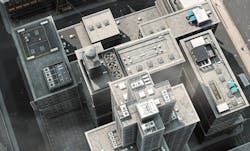3 High-Tech Tools That Can Better Your Building’s Roof and Exterior
Having a master plan is crucial when it comes to maintaining your building or facility. This especially holds true for roofs, which are only as good as they perform. Roofs are met with a variety of challenges 24/7 – from the weather and natural elements to heavy equipment, foot traffic and more. Emerging roof technology tools like high-resolution imagery and advanced weather systems are enabling facility managers to be more proactive than reactive when it comes to roofs and a building’s exterior.
These high-tech systems are able to provide information remotely without site visits to a building, which can be considered an asset at a time when social distancing has become the new normal way to operate. Learn how you can improve your roof’s integrity and make it more efficient with the new technologies below.
Hi-Res Imagery Solutions
Aerial imagery and data insights are two key ways for facility managers and building owners to make smarter decisions for their properties. Pete Cleveland, vice president of product strategy for EagleView, says this type of technology allows users to gain all kinds of insights, such as water damage on the roof, determining material quantities for roof replacement projects, green roof design and more.
“We can offer our customers not only remote visions of a property from aerial imagery, but they can also obtain this data and structural geometries to help inform decisions that can help businesses become more effective,” he says.
1. EagleView
EagleView is a technology provider of aerial imagery, data analytics and geographic information system solutions. The Washington-based company has over 200 patents in the aerial property measurement field and has a multi-modal database that covers 98% of the U.S. population. It obtains its data mainly through camera systems embedded in different aircraft that fly nearly 10 million miles a year, but Cleveland notes that EagleView is also now working with unmanned aerial vehicles like drones.
EagleView’s high-resolution aerial imagery can provide details as fine as 0.75 inches ground sample distance, which is 16 times clearer than a satellite view, according to the company’s website. Facility managers or business owners can get vertical views of their property which gives a top-down perspective, or oblique images that capture more angles and views of a building’s sides.
These different views can help make more informed decisions, such as the best place to put a new green roof. “The technology can facilitate solar designs as it can determine how much sunlight hits that roof, which in turn determines that roof’s production values,” says Cleveland.
To put it simply, this type of technology helps users see what is working on a building’s roof and what is not.
[Related: Covid-19 and Roofing]
2. Nearmap
Nearmap is another technology and location data company that provides frequently updated, high-resolution aerial imagery. Founded in Australia in 2008, the company expanded into the U.S. in 2014 and obtains images in densely populated areas multiple times a year.
Although systems like Google aerial maps might be free, Nearmap notes on its website that these images can lack detail or be years out of date. Amanda Marchetti, product manager for location content at Nearmap, says their images provide details as fine as 5.5 centimeters ground sample distance.
“When I look at Google imagery, I can tell the difference between a sedan and a pickup truck,” she notes. “With Nearmap imagery, I can often tell you what’s in the bed of that pickup truck. That’s what 5.5 centimeters brings you. It gives you the clarity to be able to definitively see, understand and interpret what’s happening on the ground.”
Nearmap’s products provide different kinds of imagery, including vertical and oblique, as well as 3D, which provides immersive, photorealistic exploration of metro areas, and Opensolar, which can be used as a solar estimating tool.
Weather Intelligence
3. Climacell
Weather can take a huge toll on a roof, especially rain and snow. Facility managers and building owners can better prepare for extreme weather conditions with technology like Climacell, a U.S. weather technology company that repurposes wireless communication networks for advanced weather forecasting. Although weather apps and meteorologists provide free forecast predictions, Climacell gives weather conditions that pertain directly to building owners.
“It’s delivering the forecast in a way that’s insightful to make operational decisions,” says Michael Lasco, director of commercial sales at Climacell. “What’s great about this is it’s not giving you just a percent chance of snow anymore. It’s a binary yes or no, when is it going to start snowing, the intensity as well, and the stop time.”
[On Topic: Roof Repairs in Extreme Weather Conditions]
By delivering precise information about what weather is doing in a specific area, Climacell can improve readiness and reduce costs, as it enables facility managers to respond and recover more efficiently. The company’s HyperCast system, for example, offers an all-in-one weather dashboard, so facility managers get all the information they need in one place. It can work for a single building or an entire portfolio.
“In multiple property situations, the locations with the highest risk and the most going on will be automatically filtered at the top so you can prioritize the biggest issues first,” notes Ali Noel, Climacell’s product marketing director.
“I think the big value in terms of property owners and building owners is that you never want to be caught by surprise,” she adds. “Climacell allows you to be hyper-accurate and hyper-local, so instead of relying on a forecast that is coming from a station 30 miles away, we’re actually able to see from a latitude-longitude perspective when that snow or storm is going to hit a particular property or location.”
Between gathering precise data for weather conditions and crystal-clear images of a building’s exterior, it’s clear that intelligent roof and exterior monitoring can go a long way into protecting a building both physically and financially.
Read next: Roofing Systems
About the Author

Adrian Schley
Staff Writer
Adrian Schley has been writing for interiors+sources magazine since March of 2018 and creates content for the BUILDINGS team. She earned her BA in journalism at the University of Iowa, where she also studied English.
